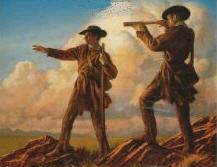
|
"We set out early and proceeded on..." |

|
"We set out early and proceeded on..." |
|

|
The members of the Lewis and Clark expedition were masters of
the wilderness, with years living in military and hunting camps, in the forest, and on the frontier.
They all were skilled boatmen, or quickly became so,
and much of the trip was made with boats and canoes.
They were familiar with
wood, leather, and horses, and knew how to use tools.
Living off the land was natural to many of them. This page collects a
variety of sources of information
about the skills, clothing and equipment they used to advance the
journey and to survive in the wilderness.
When the expedition departed seven tons of supplies and equipment were shipped in the boats. There was a very large variety of equipment, from swivel guns to portable microscopes. Note that in many cases we do not know the exact details of equipment used by the expedition. But we can infer what they used from planning records, journal entries, and the uses of the times. For Classroom discussion: Have students select and explain a single skill or tool they depended on for their survival and success. Artifacts and Documents Read the Journals for the actual basis of our knowledge. Lewis and Clark: Across the Divide. Carolyn Gilman. Smithsonian. 416 pp. 400 illus. October 2003. "...results of a five-year enterprise to trace and authenticate the original artifacts, documents, maps, and artwork of the Lewis and Clark Expedition. ... material from over 50 institutions..." Companion to the "National Lewis and Clark Bicentennial Exhibition." A great deal of detailed information about surviving and related artifacts of the period. Where Two Worlds Meet: The Great Lakes Fur Trade. Caroline Gilman. Minnesota Historical Society, St Paul, 1982. "Has lots of artifact photos, carefully described and dated and good information on beaver trade, for example. Lots of photos of kettles and tools, pipes and pipe tomahawk, clothing, Indian trade goods...." Clothing Lewis and Clark: Tailor Made, Trail Worn; Army Life, Clothing and Weapons of the Corps of Discovery. Robert J. Moore and Michael Haynes (illustrator). Far Country Press, P.O. Box 5630, Helena MT 59604. $39.95. 2003. This is the outstanding description of clothing used by the expedition, which was largely military, so long as it lasted. Years of detailed research went into this work, and no amateur scholar or reenactor could hope to achieve all this in a lifetime of work. Historians, museum personnel, reenactors, and (we hope) filmmakers should rely on this book. Of course civilian and mountain apparel were worn as well, but no more tricorner hats, fur or coonskin caps, please, or large beards for soldiers, or 1830's mountain man finery. The expedition was not free trappers on a spree. This book also details firearms, edged weapons, tents and some accoutrements. For a much shorter summary of the clothing of the expedition see the web site Preparing for the Trip West: Clothing from the National Park Service. This includes a list of clothing and equipment probably issued to individual expedition members. But if you are serious or curious about outfits, get Moore and Haynes. Firearms 
Replica of expedition rifle, Harpers Ferry National Historical Park, National Park Service. See the link about firearms in the left column on this page, and see Discovering Lewis & Clark: Survival Tools by Michael Carrick. The two sources just above are the most up to date and complete descriptions of the firearms. Soon a more extensive review will be published" "Firearms of the Lewis and Clark Expedition," Stuart Wier, in print, We Proceeded On, 2005. Boats Boats -- the keelboat, pirogues, and a succession of dugout canoes -- were the chief means of transport for the expedition. See On the River with Lewis and Clark. Vern Huser. Texas A & M University Press. $17.95. 1-800 826-8911. "...what it was like to carry out such an expedition, ... wind and water... construction of the watercraft,.... dangerous incidents along the rivers." See also "On the Rivers with Lewis and Clark". by Verne Huser. We Proceeded On, May 2003. pp 17-24.
The Keelboat Age on Western Waters. Leland Baldwin. circa 1780 -1820. 264 pages.
Keelboat, Pirogue, and Canoe: Vessels Used by the Lewis and Clark
Corps of Discovery. Richard Boss. Nautical Research Journal,
June 1993.
Keelboat Building
( http://www.lewisandclarkeast.org/boat_building.html )
Web Sites about Outfitting the Expedition, and Reenactments
This is an excellent collection of detailed information:
National Council of the Lewis and Clark
Bicentennial Signature Events
The Lewis and Clark Discovery Expedition of St. Charles, Missouri.
Re-Enactor Guide For Volunteers Of the Discovery Expedition(Microsoft Word doc file)
| |||||||||||||||
|
|
||||||||||||||||